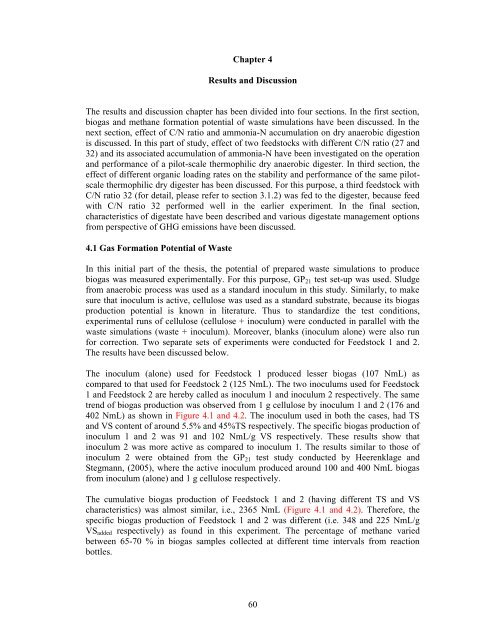dry anaerobic digestion of municipal solid waste and digestate ...
dry anaerobic digestion of municipal solid waste and digestate ...
dry anaerobic digestion of municipal solid waste and digestate ...
Create successful ePaper yourself
Turn your PDF publications into a flip-book with our unique Google optimized e-Paper software.
Chapter 4<br />
Results <strong>and</strong> Discussion<br />
The results <strong>and</strong> discussion chapter has been divided into four sections. In the first section,<br />
biogas <strong>and</strong> methane formation potential <strong>of</strong> <strong>waste</strong> simulations have been discussed. In the<br />
next section, effect <strong>of</strong> C/N ratio <strong>and</strong> ammonia-N accumulation on <strong>dry</strong> <strong>anaerobic</strong> <strong>digestion</strong><br />
is discussed. In this part <strong>of</strong> study, effect <strong>of</strong> two feedstocks with different C/N ratio (27 <strong>and</strong><br />
32) <strong>and</strong> its associated accumulation <strong>of</strong> ammonia-N have been investigated on the operation<br />
<strong>and</strong> performance <strong>of</strong> a pilot-scale thermophilic <strong>dry</strong> <strong>anaerobic</strong> digester. In third section, the<br />
effect <strong>of</strong> different organic loading rates on the stability <strong>and</strong> performance <strong>of</strong> the same pilotscale<br />
thermophilic <strong>dry</strong> digester has been discussed. For this purpose, a third feedstock with<br />
C/N ratio 32 (for detail, please refer to section 3.1.2) was fed to the digester, because feed<br />
with C/N ratio 32 performed well in the earlier experiment. In the final section,<br />
characteristics <strong>of</strong> <strong>digestate</strong> have been described <strong>and</strong> various <strong>digestate</strong> management options<br />
from perspective <strong>of</strong> GHG emissions have been discussed.<br />
4.1 Gas Formation Potential <strong>of</strong> Waste<br />
In this initial part <strong>of</strong> the thesis, the potential <strong>of</strong> prepared <strong>waste</strong> simulations to produce<br />
biogas was measured experimentally. For this purpose, GP21 test set-up was used. Sludge<br />
from <strong>anaerobic</strong> process was used as a st<strong>and</strong>ard inoculum in this study. Similarly, to make<br />
sure that inoculum is active, cellulose was used as a st<strong>and</strong>ard substrate, because its biogas<br />
production potential is known in literature. Thus to st<strong>and</strong>ardize the test conditions,<br />
experimental runs <strong>of</strong> cellulose (cellulose + inoculum) were conducted in parallel with the<br />
<strong>waste</strong> simulations (<strong>waste</strong> + inoculum). Moreover, blanks (inoculum alone) were also run<br />
for correction. Two separate sets <strong>of</strong> experiments were conducted for Feedstock 1 <strong>and</strong> 2.<br />
The results have been discussed below.<br />
The inoculum (alone) used for Feedstock 1 produced lesser biogas (107 NmL) as<br />
compared to that used for Feedstock 2 (125 NmL). The two inoculums used for Feedstock<br />
1 <strong>and</strong> Feedstock 2 are hereby called as inoculum 1 <strong>and</strong> inoculum 2 respectively. The same<br />
trend <strong>of</strong> biogas production was observed from 1 g cellulose by inoculum 1 <strong>and</strong> 2 (176 <strong>and</strong><br />
402 NmL) as shown in Figure 4.1 <strong>and</strong> 4.2. The inoculum used in both the cases, had TS<br />
<strong>and</strong> VS content <strong>of</strong> around 5.5% <strong>and</strong> 45%TS respectively. The specific biogas production <strong>of</strong><br />
inoculum 1 <strong>and</strong> 2 was 91 <strong>and</strong> 102 NmL/g VS respectively. These results show that<br />
inoculum 2 was more active as compared to inoculum 1. The results similar to those <strong>of</strong><br />
inoculum 2 were obtained from the GP21 test study conducted by Heerenklage <strong>and</strong><br />
Stegmann, (2005), where the active inoculum produced around 100 <strong>and</strong> 400 NmL biogas<br />
from inoculum (alone) <strong>and</strong> 1 g cellulose respectively.<br />
The cumulative biogas production <strong>of</strong> Feedstock 1 <strong>and</strong> 2 (having different TS <strong>and</strong> VS<br />
characteristics) was almost similar, i.e., 2365 NmL (Figure 4.1 <strong>and</strong> 4.2). Therefore, the<br />
specific biogas production <strong>of</strong> Feedstock 1 <strong>and</strong> 2 was different (i.e. 348 <strong>and</strong> 225 NmL/g<br />
VSadded respectively) as found in this experiment. The percentage <strong>of</strong> methane varied<br />
between 65-70 % in biogas samples collected at different time intervals from reaction<br />
bottles.<br />
60

















